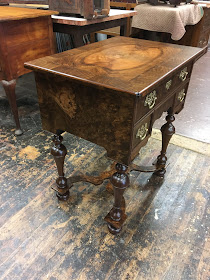 |
| Anger Management Issues Much? |
My main point was that fakes can live long enough to be considered antique, simply by age. For example, at the Getty Museum there is a French piece of furniture, made around 1790. At that time it was a fad to deconstruct old Boulle furniture (which was probably in poor condition) and use the elements to remanufacture new pieces. Therefore, what might be considered a fake in some intellectual circles now is proudly displayed in a major museum as an artifact of that period.
The other point of my talk is this: If you counterfeit money and take it to the bank it is recognized and destroyed. By keeping fake money out of the market, the true value of real currency is protected. However, there are thousands of examples of actual fake antiques which are bought and sold every day. When these are recognized, they are then considered to have "decorative" value instead of "antique" value. Often the price is the same.
I think I have told the story of a rather large "Louis XV Television Cabinet" that has been living in Los Angeles for several decades. I was first confronted with this object when I was hired to provide my expert opinion as to its age. It was fairly easy to determine that it was put together with the parts from two different 18th century French armoires. However, the price that the client paid was $240,000. When our report was submitted to the client with our findings, the decision was made to return it to the dealer.
About 5 years later I was again on a job in Los Angeles, in a wonderful large mansion. I was asked to look at a sideboard in the dining room. As it was my first meeting with that particular client, I wanted to impress him with some of my background experience, and I told him about the "Louis XV Television Cabinet." His expression was of utter shock and he said that I had better look at the antique armoire in his master bedroom.
Of course, as I entered the room I was immediately aware that it was the same piece. And that it had been purchased at the same ridiculous price. Fortunately, he was able to return it to the dealer.
A year later, as I drove down Robinson in Los Angeles, past the antique dealer's shop, there it was, sitting in the window, ready to be sold again.
Last year I gave a lecture at my old school, UCSD, to a group of collectors. You can watch the talk which I posted on an earlier page of this blog. After this talk, two of the audience members brought an antique to my shop for restoration. It was carefully wrapped and had been kept in storage for several years. They mentioned that it had been in the family for generations and was valuable.
As soon as I saw it my heart sank. I do not like being the bearer of bad news, but I am compelled to speak the truth, and my many years of experience provides me with the background to know what I am talking about.
"Unfortunately, this is an English fake which was made around 1900."
They were crestfallen. They just asked what it would cost to restore it, and then decided to just walk away. It was free to me and a terrible loss to them.
It was supposed to be a William and Mary dressing table from around 1700.
 |
| Got to Love the Legs! |
This was what it looked like:
 |
| Veneer Attached With Contact Cement |
 |
| Old Finish Covers Sins |
 |
| Proper Turned Leg or Modern Cabriole Leg |
 |
| Rough Turning in Walnut |
Since the fake had rather nice brass hardware and lock, and the casework and drawers were rather well made, I decided to skin it and add the proper burl walnut veneer with herringbone banding and hand made molding. I also designed and veneered a proper stretcher.
 |
| Still a Fake |
 |
| I Like the Pattern |
 |
| Big Improvement |
I wonder if at some distant time it will be considered important and stand in a major museum as an example of this time?
Just sayin...
 |
| Now What Do I Do With It??? |
 |
| Fake Antique |










































